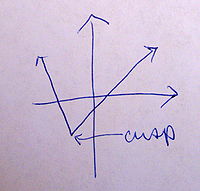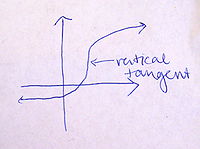Science:Math Exam Resources/Courses/MATH110/December 2012/Question 02 (e)
{{#incat:MER QGQ flag|{{#incat:MER QGH flag|{{#incat:MER QGS flag|}}}}}}
• Q1 (a) • Q1 (b) • Q2 (a) • Q2 (b) • Q2 (c) • Q2 (d) • Q2 (e) • Q2 (f) • Q3 (a) • Q3 (b) • Q3 (c) • Q3 (d) • Q4 • Q5 • Q6 • Q7 (a) • Q7 (b) • Q8 • Q9 (a) • Q9 (b) • Q9 (c) • Q10 •
Question 02 (e) |
|---|
|
Determine whether the following statement is true or false. If it is true, provide justification. If it is false, provide a counterexample. If a function is continuous, then it is differentiable. |
|
Make sure you understand the problem fully: What is the question asking you to do? Are there specific conditions or constraints that you should take note of? How will you know if your answer is correct from your work only? Can you rephrase the question in your own words in a way that makes sense to you? |
|
If you are stuck, check the hint below. Consider it for a while. Does it give you a new idea on how to approach the problem? If so, try it! |
Hint |
|---|
|
What makes a function non-differentiable? Can you draw a continuous function with this property? |
|
Checking a solution serves two purposes: helping you if, after having used the hint, you still are stuck on the problem; or if you have solved the problem and would like to check your work.
|
Solution |
|---|
|
A function is non-differentiable if it has a vertical tangent or a sharp corner (cusp). A function is continuous if it can be drawn in one go without lifting your pencil. It is possible to draw a continuous function with one (or multiple!) of the non-differentiable properties just listed: So a function can be continuous, without necessarily being differentiable. Thus the statement is false. |
{{#incat:MER CT flag||
}}


